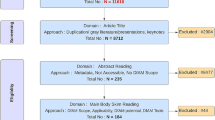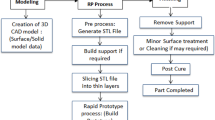
Overview
- Includes numerous practical examples on how to design components to be suitable for additive manufacturing
- Provides in-depth coverage not only of the printing processes themselves, but also of the many post-processing techniques that must be used in additive manufacturing
- Helps readers understand the design factors that can affect the economic viability of additive manufacturing
Part of the book series: Springer Series in Advanced Manufacturing (SSAM)
Access this book
Tax calculation will be finalised at checkout
Other ways to access
About this book
This book provides a wealth of practical guidance on how to design parts to gain the maximum benefit from what additive manufacturing (AM) can offer. It begins by describing the main AM technologies and their respective advantages and disadvantages. It then examines strategic considerations in the context of designing for additive manufacturing (DfAM), such as designing to avoid anisotropy, designing to minimize print time, and post-processing, before discussing the economics of AM.
The following chapters dive deeper into computational tools for design analysis and the optimization of AM parts, part consolidation, and tooling applications. They are followed by an in-depth chapter on designing for polymer AM and applicable design guidelines, and a chapter on designing for metal AM and its corresponding design guidelines. These chapters also address health and safety, certification and quality aspects. A dedicated chapter covers the multiple post-processing methods for AM, offering the reader practical guidance on how to get their parts from the AM machine into a shape that is ready to use. The book’s final chapter outlines future applications of AM.The main benefit of the book is its highly practical approach: it provides directly applicable, “hands-on” information and insights to help readers adopt AM in their industry
Similar content being viewed by others
Keywords
- Design for Additive Manufacturing (DfAM)
- Light-Weighting
- Topology Optimisation
- Additive Manufacturing Economics
- Polymer Additive Manufacturing
- Metal Additive Manufacturing
- Additive Manufacturing Post-Processing
- Rapid Prototyping
- Layer-Based Fabrication
- Layer-Based Manufacturing
- AM Computational Design
Table of contents (14 chapters)
-
Front Matter
-
Back Matter
Authors and Affiliations
About the authors
Axel Nordin holds an M. Sc. in Mechanical Engineering from Lund University, Sweden, and a Ph.D. of Engineering from the division of Machine Design. He has participated in several government funded research projects. His work is mainly concerned with studying aspects of integrating complex morphologies into bespoke products, such as computational, manufacturing, structural, and usability challenges, as well as in topology optimisation and generative design, and how these can be applied in the field of design for additive manufacturing.
Damien Motte is an associate professor at the division of product development with the School of Engineering at Lund University, Sweden. He received a PhD from thesame division, a research master from the Industrial Engineering Laboratory at École Centrale Paris, France, and an MSc in Industrial Engineering at École des Mines d’Albi, France. His area of research focus includes alternative engineering design, design for additive manufacturing, and product development methodologies.
Bibliographic Information
Book Title: A Practical Guide to Design for Additive Manufacturing
Authors: Olaf Diegel, Axel Nordin, Damien Motte
Series Title: Springer Series in Advanced Manufacturing
DOI: https://doi.org/10.1007/978-981-13-8281-9
Publisher: Springer Singapore
eBook Packages: Engineering, Engineering (R0)
Copyright Information: Springer Nature Singapore Pte Ltd. 2019
Hardcover ISBN: 978-981-13-8280-2Published: 29 May 2019
Softcover ISBN: 978-981-13-8283-3Published: 14 August 2020
eBook ISBN: 978-981-13-8281-9Published: 21 May 2019
Series ISSN: 1860-5168
Series E-ISSN: 2196-1735
Edition Number: 1
Number of Pages: XX, 226
Number of Illustrations: 33 b/w illustrations, 180 illustrations in colour
Topics: Engineering Design, Manufacturing, Machines, Tools, Processes, Nanotechnology



